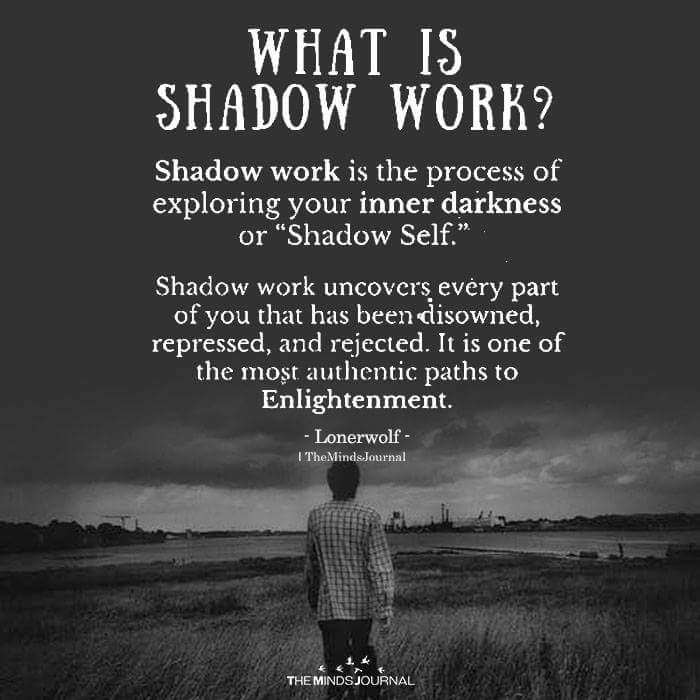Want to unlock the door to a richer, fuller life? All you need to do is explore the hidden corners of your own psyche. Discover how to do shadow work for beginners and embark on a transformative journey that can elevate your life in unimaginable ways.
Explore Your Shadow Side
Imagine waking up every day, feeling like you’re not living your life to its fullest potential. Do you ever feel that way? You’re not alone. Meet Rebecca, a charming 32-year-old woman who seems to have everything – looks, a loving family, and a stable job.
And yet, Rebecca often finds herself engulfed in emotions she doesn’t quite understand. Anger, jealousy, resentment – they lurk in the corners of her mind, showing up uninvited. She’s long wondered how to address these feelings until she stumbled upon the transformative practice known as shadow work.
If you’re like Rebecca and feel like there’s a part of you that’s hidden, locked away, or if you have emotions that sometimes control you instead of the other way around, then shadow work can do wonders for you.
So let’s dive deep into how to do shadow work, so you can transform those shadows into stepping stones toward a more authentic life. Stick around, because each section is an essential piece of the puzzle.
Related: Shadow Work: How to Let Your Inner Demons Guide You
What is Shadow Work?
The term “shadow” was first coined by the Swiss psychiatrist Carl Jung, referring to the unconscious aspects of our personality we’re less aware of or prefer to suppress.
Shadow work is the practice of uncovering and understanding these dark corners of ourselves to live a more balanced and fulfilling life. It is a type of psychotherapy that delves into the concealed, disregarded, or unfavorable facets of an individual’s self.
The process involves engaging with the subconscious mind to reveal elements of oneself that have been suppressed or kept hidden. This might encompass past traumas or fragments of one’s personality that have been unconsciously deemed undesirable.

Essentially, shadow work revolves around cultivating a heightened consciousness of oneself, leading to eventual self-acceptance and the nurturing of compassion. It often intertwines therapeutic and spiritual dimensions, aiding in the recognition and reconciliation of the diverse aspects within an individual’s being.
Learning how to do shadow work is like embarking on an inner pilgrimage. It’s about facing the darkest facets of yourself, not to annihilate them, but to transform them into light.
Why Rebecca Turned to Shadow Work
Rebecca had a constant battle with jealousy. Every time her friends shared their achievements or milestones, she felt a pang in her chest. It was as if their happiness somehow diminished her own worth.
She tried to suppress these feelings, but they would erupt in moments of vulnerability. Rebecca wanted to free herself from this cycle, and that’s when she discovered the concept of shadow work.
How to do shadow work for beginners
Shadow work is a deeply intricate process that has many facets and approaches. Simply follow these steps to start working on your shadow self –
Step 1: Recognize Your Shadow
Identification is key. The first step involves recognizing your shadow self. This isn’t about demonizing parts of yourself but acknowledging that they exist.
Rebecca sat down with a journal and wrote down instances where she felt overwhelmed by jealousy. She realized that her jealousy usually surfaced in situations where she perceived others as more successful or happier than her.
Step 2: Understand the Origin
\After identifying your shadow, the next step is to trace these traits and repressed emotions back to their roots.
Rebecca found that her jealousy stemmed from her childhood experiences where she constantly felt overshadowed by her elder sister, who was often praised for her accomplishments. This led to a deep-rooted belief that she was not good enough.
Step 3: Observe Without Judgment
The third step in learning how to do shadow work is to become an observer. Look at your emotions and thoughts from a third-person perspective, observe them without judgment and without getting attached to them.
Every time Rebecca felt jealous, she stopped and observed her thoughts without labeling them as ‘bad’ or ‘wrong’. This allowed her to detach herself from the emotion and gain a clearer understanding.
Step 4: Validate Your Emotions
The next step involves validating your emotions. These feelings are a part of you and they have a purpose.
Rebecca understood that her jealousy was a signal pointing to her deeper issues of self-worth and validation. She validated her emotions by acknowledging that they served as indicators to aspects of herself she needed to address.
Step 5: Integrate the Shadow
The ultimate aim of shadow work is to integrate these aspects into your conscious personality, accepting them as a part of you.
Rebecca found ways to cope with her jealousy by using it as a motivator to improve herself. She even talked openly about her struggle with close friends, which not only helped her integrate her shadow but also made her relationships more authentic.
Step 6: Acknowledge Your Strengths
Your shadow self isn’t just about negative aspects; acknowledging your strengths is also an important part of how to do shadow work for beginners.
For every shadow aspect Rebecca identified, she also wrote down a strength of hers. This balanced approach helped her see that she was not defined by her shadows alone.
Step 7: Use Affirmations
Affirmations can serve as a guide in your journey of shadow work and self-improvement.
Rebecca wrote down affirmations like “I am worthy” or “I am more than my jealousy” and recited them daily. These became emotional anchors that helped her integrate her shadow aspects.

Step 8: Use Meditation and Mindfulness Techniques
The eighth step in mastering shadow work is integrating meditation and mindfulness into your routine.
Rebecca started incorporating 10-minute mindfulness exercises into her daily schedule. During this time, she would focus solely on her breath, allowing herself to become aware of any thoughts or feelings without judgment.
This practice helped her become more aware of her shadow aspects when they surfaced.
Related: How To Identify Your Shadow Self: Discovering Your Hidden Depths In 7 Steps
Step 9: Articulate Through Creative Expression
Artistic expression can also serve as a vessel in your journey on how to do shadow work.
Rebecca took up painting as a form of self-expression. She allowed her emotions, even the dark ones, to spill onto the canvas. This not only served as a form of release but also as a way to observe her emotions manifest in a tangible form.
Step 10: Consult trusted loved ones
Discussing your shadow work discoveries with trustworthy friends and family members can be incredibly illuminating.
Rebecca started discussing her shadow work insights with a close friend who was also interested in self-improvement. These conversations gave her new perspectives on her own emotions and thoughts.
Step 11: Perform Rituals
Rituals can help to consciously integrate your shadow into your being, adding a ceremonial aspect to shadow work.
Rebecca created a small ritual where she would write down a shadow aspect on a piece of paper and then safely burn it, signifying its transformation and integration.
Step 12: Set Boundaries
Setting boundaries is a crucial part of doing shadow work. Understanding her triggers helped Rebecca set emotional and mental boundaries.
She communicated these boundaries to her friends and family, making her personal relationships more harmonious.
Step 13: Study Archetypes
Understanding archetypes can help provide a framework on doing shadow work.
Rebecca researched Jungian archetypes like The Hero, The Mother, and The Trickster, and found these symbols helped her understand her behavior patterns better.
Step 14: Analyze Dreams
Dreams can often give clues about your unconscious mind and shadow self, providing further insights into how to do shadow work.
Rebecca started keeping a dream journal. Upon analysis, she noticed recurring themes that related to her shadow, which gave her additional areas to explore.
Step 15: Consult Shadow Work Resources
Books, courses, and webinars can offer additional guidance on shadow work.
Rebecca read various books on psychology and took online courses focused on shadow work. These resources gave her new techniques and viewpoints, enriching her journey.
Step 16: Revisit and Reflect
Understanding shadow work is not a one-time task. It’s an ongoing process.
Every month, Rebecca takes out her journal to reflect on her emotional journey. She notes down any new triggers or insights, continuously integrating her shadow into her conscious self.
Step 17: Seek Professional Help
If you find it challenging to navigate how to do shadow work by yourself, it’s okay to seek professional help. That’s why it is crucial that you know when to reach out for professional help.
Recognizing her limits, Rebecca decided to see a therapist who specialized in shadow work. This provided her with additional tools and coping mechanisms.
Following these steps can deepen your self-understanding in a holistic way. Remember, shadow work isn’t a one-off event but a lifelong journey.
Just like Rebecca, who found a deeper connection with herself through these comprehensive steps, you too can enjoy the benefits of a more integrated self by mastering how to do shadow work for beginners.
Related: How To Manage Your Dark Side – 10 Tips To Embrace Your Shadow Self
Benefits of Shadow Work
Shadow work is far from just a buzzword in the realms of psychology and self-improvement; it’s a fundamental process that allows you to dig deep into your inner self, revealing aspects of your personality and emotions that you might not be conscious of.
But why is it crucial? And how did it benefit someone like Rebecca? Let’s dive in.
1. Psychological Freedom
We all have an image of who we are, often shaped by societal expectations, family upbringing, and personal experiences. Sometimes, this image becomes a cage that restricts us from experiencing the full range of human emotions and possibilities.
Shadow work aims to dismantle this cage, allowing us a psychological freedom that’s indispensable for a fulfilling life. This is one of the most prominent benefits of shadow work.
For Rebecca, this psychological freedom manifested as a release from the intense jealousy that once consumed her. No longer did she feel the need to suppress these feelings, instead, she was able to approach them openly, understand them, and ultimately control them.
2. Enhanced Relationships
When we do shadow work, it allows us to be more genuine in our interactions with others. We become more self-aware, which in turn makes us more empathetic and understanding in our relationships.
In Rebecca’s case, by acknowledging her own shadow traits, she became more tolerant of the imperfections in others. Not only did she feel closer to her friends and family, but her relationships also became a platform where vulnerability and authenticity were celebrated.
3. Increased Self-Awareness
Understanding yourself is the cornerstone of any kind of personal development. The steps in how to do shadow work lead you into this understanding by forcing you to confront aspects of yourself you’d rather not think about. The process can be uncomfortable, but the rewards are immense.
As Rebecca delved into her shadow work, she discovered why she felt the way she did, not just about jealousy but other negative emotions she had suppressed over the years. This self-awareness became a tool she could use to navigate other challenging situations and emotions in her life.

4. Emotional Balance
By acknowledging your negative emotions and hidden aspects, you’re not letting them control you unconsciously. This is one of the benefits of shadow work that leads to a more balanced emotional life where you’re not reacting impulsively to triggers but responding thoughtfully.
Before shadow work, Rebecca’s jealousy would often tip her into emotional extremes, leading her to act out in ways she later regretted. Understanding and integrating her shadow self helped stabilize her emotional life, offering her the balance she needed to be a more composed individual.
5. Personal Growth and Empowerment
As you peel back the layers of your unconscious, you uncover not just your weaknesses but also your hidden strengths. The benefits of shadow work allows you to face your fears, confront your shames, and turn them into powerful tools for personal growth.
Through shadow work, Rebecca was empowered to use her feelings of jealousy as a motivator to better herself, instead of allowing it to be a destructive force in her life. It gave her the courage to face other aspects of her life with renewed vigor.
6. Closing the Gap Between the Ideal and Real Self
Most of us have an idealized version of ourselves that we aspire to become. Shadow work is vital because it closes the gap between who we pretend to be and who we actually are, bringing us closer to becoming the person we genuinely want to be.
Rebecca was no longer living in the disconnect between her ideal and real self. She found her authentic voice and began living in a way that was more aligned with her core values, rather than societal expectations or an idealized self-image.
7. Holistic Well-being
The benefits of shadow work extend beyond the mental and emotional, often positively impacting our physical health. Stress, which has numerous adverse effects on the body, is often a result of unaddressed emotional and psychological issues.
As Rebecca learned how to do shadow work for beginners, she noticed a significant reduction in stress, leading to better sleep and overall improved health. This newfound wellness made it easier for her to focus on other areas of her life, such as career and family.
The Imperative of Shadow Work
Doing shadow work isn’t a luxury; it’s a necessity for anyone seeking to live an integrated, authentic life. It’s a transformative process that gives you the keys to unlock a more honest relationship with yourself and others.
Rebecca’s life-changing experience with shadow work is a testament to its profound impact. Just like her, you too can benefit from this practice, setting you on a path to a more fulfilling life.
So, if you’ve ever wondered how to do shadow work, remember that the journey, although difficult, yields invaluable rewards that ripple through every aspect of your existence.
Related: How To Own Your Shadow Before It Owns You: 7 Helpful Exercises
Frequently Asked Questions (FAQs):
How long does it take to do shadow work?
The duration of shadow work varies. It can take weeks to years, depending on depth and personal progress.
How do I accept my shadow self?
Embrace shadow self with self-compassion, reflection, therapy, and inner exploration. Gradual acceptance fosters personal growth and understanding.
Is shadow work good for beginners?
Yes, shadow work can benefit beginners. Start with self-awareness, patience, and guidance from therapists, mentors, or resources.










Leave a Reply